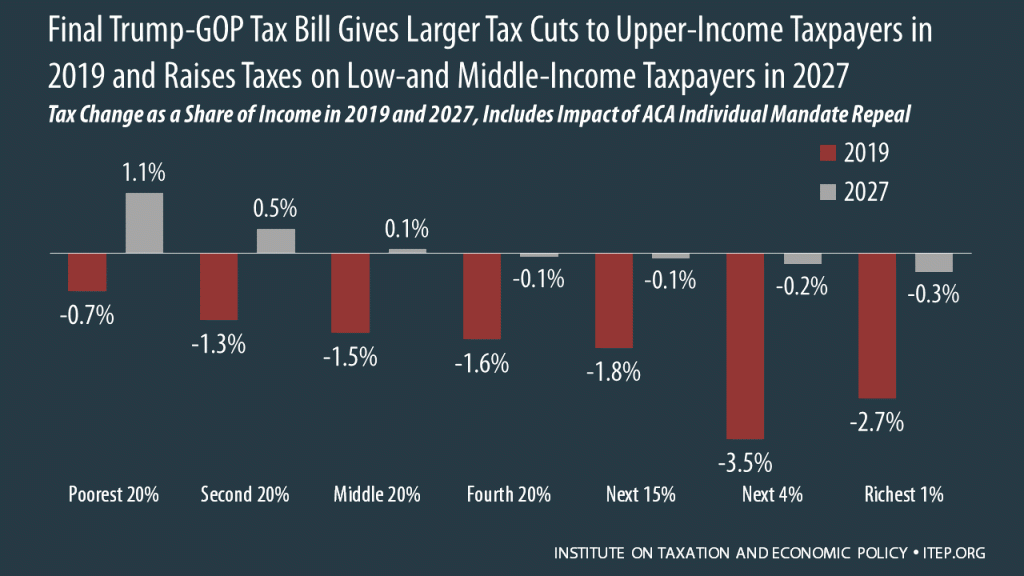Gov. Andrew Cuomo last week unveiled his proposed sweeping overhaul to New York’s tax code in response to the recently enacted federal tax law. The plan includes decoupling the state’s personal income tax code from most of the federal changes that otherwise would have hit the state. Most significantly, Cuomo also put forth a few pieces of legislation predicated on allowing taxpayers to avoid the $10,000 cap on state and local tax (SALT) deductions that they can claim on their federal forms, a limit imposed by the Trump-GOP tax law.
In the Empire State and elsewhere, a lot of time and attention has been poured into these “work around” options. As ITEP has explained, if Congress repeals the SALT cap, or if state legislatures find a way to allow their residents to avoid it, the benefits would go mainly to high-income households. In New York, the richest 1 percent of the state’s residents would reap 67 percent of the benefits, and the state’s richest 5 percent would reap 86 percent of the benefits.
In other words, such work arounds would deliver additional tax savings to the taxpayers who benefit most under recent federal changes. But that seems to be the goal of the new proposal from Gov. Andrew Cuomo to “work around” the SALT cap. It would shift many taxpayers away from fully paying the state’s personal income tax in favor of a new payroll tax and the option to contribute to two charitable funds.
Payroll Tax Scheme
New York’s SALT work around would move taxpayers away from the income tax to an employer paid payroll tax which, in theory, would reduce employee wages and federal tax liability while holding them harmless at the state level.
The voluntary payroll tax, dubbed the employer compensation expense tax, would be phased in over the course of three years, starting in 2019. In practice, instead of workers paying state income taxes, their wages would be reduced by their employers, who would take on the responsibility of paying a state payroll tax on the net wages. The employers could then deduct those payroll tax amounts from their federal taxes—unlike many workers who will see their ability to deduct state tax payments eliminated or reduced by the new federal law—and employees would take a credit against their state income taxes equivalent to the payroll tax. Additionally, New York taxpayers would benefit from reduced federal taxes since they would have lower wages to report on federal returns.
The net result of workers’ reduced wages and state tax savings would be to end up with roughly the same take-home pay. In the first year, employers would pay a 1.5 percent payroll tax. That would increase to 3 percent in the second year and 5 percent in the third and final year.
Charitable Scheme
Also, two new charitable funds would provide funding for health care and education, which together make up 60 percent of state spending. A state tax credit would be made available to taxpayers who contribute to those funds. The credit would be set at 85 percent of the amount contributed, meaning that taxpayers would receive a state tax reimbursement for the vast majority of amounts they donate.
By allowing taxpayers to make very-low-cost “charitable donations” in this way, the state would offer its residents an easy way to beef up their federal itemized deductions even in the wake of the capping of the deduction for state and local taxes paid. This is because deductions for charitable contributions were retained and expanded under the new federal tax law. If advanced, school districts and local governments will also be provided the opportunity to create their own charitable funds to offset taxpayers’ local property tax payments.
Wrong on What Needs to Be Fixed
The Trump-GOP tax law presents many serious problems, but not the ones cited by Cuomo’s Department of Taxation and Finance in their report laying out several “work around” options. The report claims that the new federal law risks “undermining the progressivity of New York’s tax system” and “investments and services that the state provides for its residents.” This is not true. On its own, the cap on deducting state and local taxes under the new federal law does not necessarily have to change the amount of state tax paid by anyone, and it does not change the amount of revenue flowing into state coffers.
Gov. Cuomo has repeatedly mentioned the $14.3 billion “tax increase” that New Yorkers will face as a result of the SALT deduction cap as justification for pursuing work arounds. That figure, however, is the difference between what New Yorkers used to be able to itemize versus allowable deductions under the new law. An ITEP analysis found that New York taxpayers will see a net $15.8 billion federal tax cut under the Trump-GOP law in 2019.
So what is the concern for New Yorkers? Some wonder whether the loss of tax deductions in a higher-tax state like New York will cause the wealthy to flee the state. Opponents of progressive taxes often claim that this occurs but there is no evidence of it. For instance, a recent ITEP study shows that millionaires are actually less mobile than the rest of us, refuting the claim that changes to state taxes lead to a meaningful amount of “tax flight” among top earners.
Perhaps more importantly, most high-income people in New York and every other state pay lower taxes, not higher taxes, under the Trump-GOP tax law. It’s difficult to imagine that these households feel particularly motivated to move out of state to avoid taxes when most of them are paying less as a result of the federal tax changes.
The real problem is that the federal government will cut important investments that benefit the state, which is a very real threat following passage of a law reducing federal revenue by $1.5 trillion over a decade. States should respond by increasing investments — and raising taxes on high-income households to pay for it. There are a number of options that New York lawmakers could consider: an enhanced millionaires’ tax, reinstating the stock transfer tax, a mansion or pied-a-terre tax, or a state surtax on high-dollar estates, to name a few.
Is It Really Worth All This?
While the proposals maintain key features of the personal income tax through a hybrid tax system, questions remain as to why so much effort has been put into policies that are focused on benefiting the best-off New Yorkers. This is especially puzzling given the state’s $4.4 billion structural deficit and subsequent need for new revenue.
Any politician can score points by railing against President Trump and his wildly unfair, loophole-ridden tax law. But if New York’s working people find out they will be subjected to a new and complicated set of state tax rules all to help the richest 5 percent, they’ll wonder why a better solution that targets corporations and high-income earners who just received a sizable federal tax break, was not found. In the wake of the Trump-GOP tax law, this is a missed opportunity for lawmakers in New York to increase taxes on those who just benefited from a substantial tax cut.
Stay tuned for more from ITEP on the distributional impact of Cuomo’s proposal.





